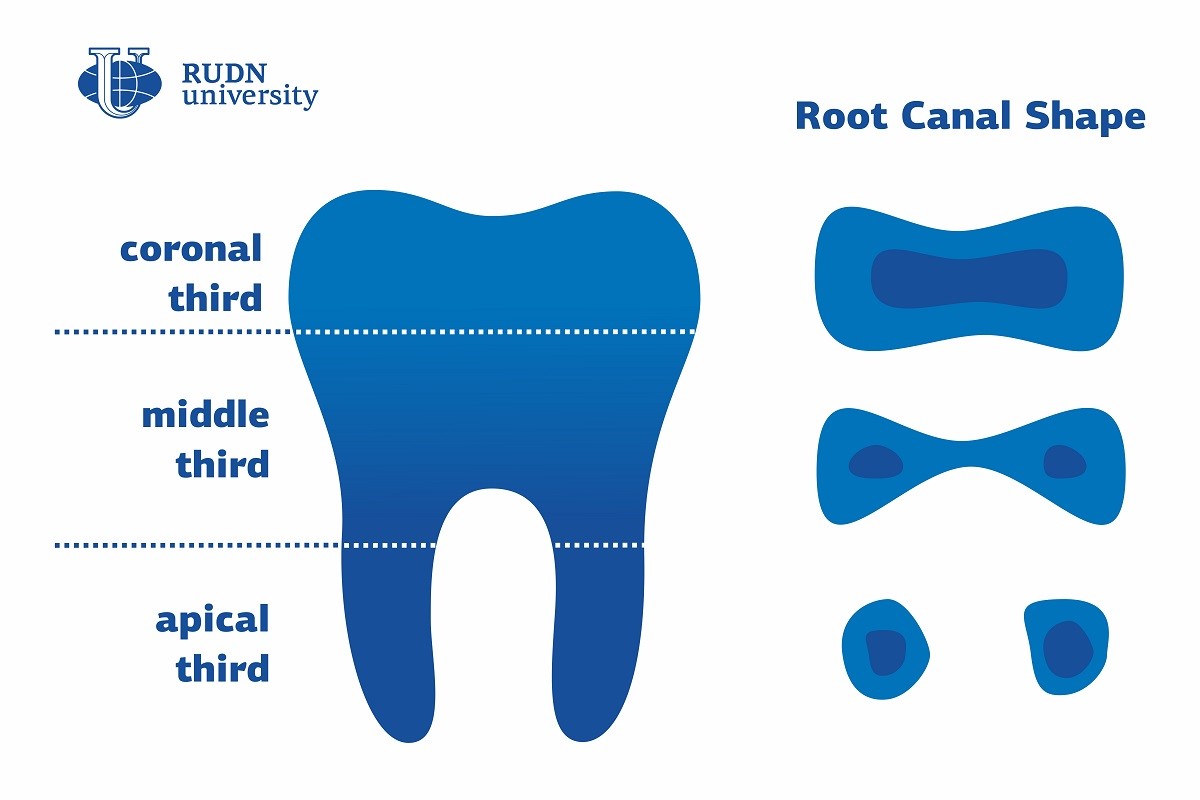Dentists from RUDN University Presented a New Classification of Root Canal Shape Changes

A root canal is a hollow space in a dental root with blood vessels and nerves going through it. Root canals have different shapes and width which makes treating them extremely complicated. Turns and shape changes can occur both in the coronal (visible) part of a tooth and in other parts that are invisible to the eye. Previous studies were focused on the curvatures of root canals in either the upper (coronal) or the lower (apical) part of a tooth. But a team of dentists from RUDN University carried out large scale research and presented the first-ever classification of root canal shape changes along its whole length.
“Earlier researchers tended to study about one-third of the root canal: either its coronal or its apical part. However, its shape changes along its full length, and this is an important factor for therapy. That is why we decided to take a look at the variations of root canal cross-sections in all three thirds and in different age groups of adult patients. Our goal was to develop a new classification of root canal shape changes,” said Svetlana Razumova, MD, a Head of the Department of Propaedeutics of Dental Diseases at RUDN University.
The team conducted an experiment that involved 300 patients from 20 to 70 years of age. The medics took CT scans of their healthy teeth in axial projection, i.e. the X-ray from the CT scanner moved along the roll axis of the teeth. This way the images showed the cross-sections of root canals. The team took 4,805 images in total and used them to study the changes in the shape of root canals depending on the part of a tooth. The images were processed using statistical methods.
The most widely spread changes in all age groups affected premolars (the teeth situated between canines and molars). In over 50% of cases, the shape of the root canal in premolars changed from round in the apical third into oval in the coronal third. Another place with frequent changes in root canal shapes was mandibular molars
Based on the obtained data the team developed a classification of root canal shape changes. The medics suggested dividing all possible changes into four groups: 1 — no changes in the shape, 2 — changes in the middle part of the root canal, 3 — changes in the middle and apical parts of the root canal, and 4 — changes in the apical part only. This classification will help dentists better understand the structure of each particular root canal and select proper tools to work with it.
“Our studies show that the shapes of root canal cross-sections can vary depending on the part of the canal and the age of a patient. All these variations were included in our classification and should be taken into consideration when choosing a method for canal cleaning. The choice of tools and preparation methods determines the efficiency of treatment at this stage and therefore affects the whole prognosis,” added Svetlana Razumova from RUDN University.
The results of the work were published in the Applied Sciences journal.
RUDN summarized the results of the scientific competition "Project Start: work of the science club ". Students of the Faculty of Physics, Mathematics and Natural Sciences have created a project for a managed queuing system using a neural network to redistribute resources between 5G segments. How to increase flexibility, make the network fast and inexpensive and reach more users — tell Gebrial Ibram Esam Zekri ("Fundamental Computer Science and Information Technology", Master's degree, II course) and Ksenia Leontieva ("Applied Mathematics and Computer Science", Master's degree, I course).
The National Demographic Report, 2023 Demographic Well-Being of Russian Regions (hereinafter - the National Demographic Report) was prepared by the scientific team of the Institute of Demographic Studies of the Federal Research Center of the Russian Academy of Sciences, the Vologda Scientific Center of the Russian Academy of Sciences, Peoples' Friendship University of Russia, the Center for Family and Demography of the Academy of Sciences of the Republic of Tatarstan, as well as with the participation of leading scientists from the Republic of Bashkortostan, Stavropol Krai, Volgograd, Ivanovo, Kaliningrad, Nizhny Novgorod, Sverdlovsk Oblasts and Khanty-Mansi Autonomous Okrug–Yugra.
RUDN summarized the results of the scientific competition "Project Start: work of the science club ". Students of the Faculty of Physics, Mathematics and Natural Sciences have created a project for a managed queuing system using a neural network to redistribute resources between 5G segments. How to increase flexibility, make the network fast and inexpensive and reach more users — tell Gebrial Ibram Esam Zekri ("Fundamental Computer Science and Information Technology", Master's degree, II course) and Ksenia Leontieva ("Applied Mathematics and Computer Science", Master's degree, I course).
What is your first association with the word “laboratory”? Flasks and beakers? Microscopes and centrifuges? Yes, many of us would answer the same way.
The National Demographic Report, 2023 Demographic Well-Being of Russian Regions (hereinafter - the National Demographic Report) was prepared by the scientific team of the Institute of Demographic Studies of the Federal Research Center of the Russian Academy of Sciences, the Vologda Scientific Center of the Russian Academy of Sciences, Peoples' Friendship University of Russia, the Center for Family and Demography of the Academy of Sciences of the Republic of Tatarstan, as well as with the participation of leading scientists from the Republic of Bashkortostan, Stavropol Krai, Volgograd, Ivanovo, Kaliningrad, Nizhny Novgorod, Sverdlovsk Oblasts and Khanty-Mansi Autonomous Okrug–Yugra.